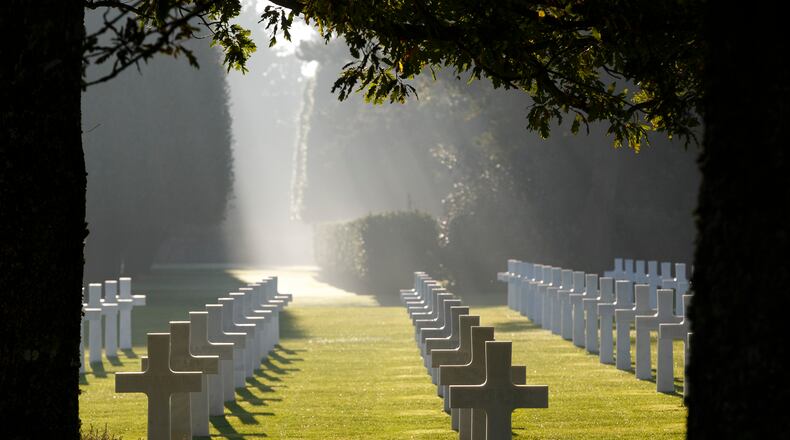Tina Clark was astonished when she learned recently that she is distantly related to a soldier who gave his life to free Europe from the Nazis. He was an elite U.S. Army Ranger. A hero.
On top of that, Clark discovered she works in the same Columbus high school Pfc. Fred Plumlee attended until his senior year in 1943. From a colleague at Jordan Vocational High School College and Career Academy, Clark obtained a yearbook photo showing Plumlee shouldering a rifle and standing at attention in the ROTC color guard. Plumlee was killed two years after that photo was published. Fresh-faced, he was just 19.
An academic dean, Clark said she and her friends are proud of Plumlee’s sacrifice on D-Day. It is something she said she will reflect on during Memorial Day.
“To know that we have somebody like that in our family, of course, makes Memorial Day much more significant for us,” said Clark, whose mother is Plumlee’s niece. “We are certainly going to think differently about Memorial Day from now on. That is for sure.”
Credit: Jordan Vocational High School College and Career Academy
Credit: Jordan Vocational High School College and Career Academy
The United States and its allies are preparing to commemorate the 80th anniversary of D-Day, the June 6, 1944 naval, air and land assault on Nazi-occupied France. A series of events will honor Plumlee and the thousands of other service members who died during the invasion.
On June 5, Gen. Michael Kurilla, who leads U.S. Central Command, will speak at an event on the French coast honoring Plumlee and the other Rangers who participated in D-Day. The following day, President Joe Biden and French President Emmanuel Macron are expected to headline a ceremony nearby at Normandy American Cemetery, where Plumlee and more than 9,000 other Americans are memorialized.
Credit: American Battle Monuments Commission
Credit: American Battle Monuments Commission
A turning point in World War II, D-Day should be remembered as “the hinge of modern history,” said Charles Djou, who leads the American Battle Monuments Commission, the agency responsible for the Normandy American Cemetery.
“Everything in this world today and how the modern world is organized, I think, arguably can be drawn to that one day, June 6, 1944,” said Djou, a U.S. Army Reserve colonel who has deployed to Afghanistan. “And it was the hinge that was purchased at enormous human cost.”
Plumlee’s Ranger company had one of the most difficult missions that day: Climbing and capturing the cliffs at Pointe et Raz de la Percée while coming under withering fire from entrenched German snipers and machine gunners. Some of the Rangers were wounded or killed as they landed on the French beaches.
Plumlee is among more than 200 U.S. military personnel who entered service in Georgia and who are memorialized at the Normandy American Cemetery, according to Djou’s commission. Of those, 18, including Plumlee, were killed on the first day of the allied invasion.
Plumlee enlisted in March of 1943 at Fort McPherson in Atlanta, according to records the American Battle Monuments Commission found on ancestrylibrary.com. The commission’s search also yielded documents tracking him to Jordan Vocational High School in Columbus.
Clark learned about her ties to Plumlee after The Atlanta Journal-Constitution asked her high school for more information about him. B. Ryan Willoughby, Jordan Vocational High School’s CEO, started digging. Eventually, he found Plumlee’s yearbook photos and a memorial written more two decades later by the class of 1943. It says Plumlee served in the student government and was the son of Mr. and Mrs. F.J. Plumlee and the brother of Irene Plumlee and Pauline Mask. Mask’s daughter, Margaret Fry, is Clark’s mother. Clark said she and her mother had never discussed Plumlee until Clark learned about him this month. Clark added she was told Plumlee’s death devastated her grandmother.
Credit: Jordan Vocational High School College and Career Academy
Credit: Jordan Vocational High School College and Career Academy
“They were apparently very close. She just did not do well with talking about it at all,” Clark said. “She loved him very much.”
Learning for the first time recently about her connection to Plumlee was sweetly gratifying for Clark.
“We just had no idea really how far-reaching things were,” she said. “We were so stunned that the world is this small.”
Georgia’s Role in World War II
- About 320,000 Georgians served in the U.S. military during World War II.
- Two airborne regiments that trained at Camp Toccoa in North Georgia and three from Fort Benning, now called Fort Moore, parachuted into France on D-Day.
- 5,701 U.S. soldiers from Georgia were killed during the war.
- More than 200 U.S. military personnel who entered service in Georgia are memorialized at the Normandy American Cemetery in France. Of those, 18 died on D-Day.
- As of 2023, there were 2,362 surviving WWII veterans in Georgia.
Sources: New Georgia Encyclopedia, Georgia National Guard History Blog, U.S. Army Center of Military History, the American Battle Monuments Commission and the National World War II Museum.
Special D-Day Documentary Screening in Atlanta
To commemorate the 80th anniversary of D-Day, the Plaza Theater in Atlanta is screening the documentary, “The Girl Who Wore Freedom,” on June 6 at 5:30 p.m. Tickets are $5 each. Purchase tickets and watch the trailer here.
Credit: American Battle Monuments Commission
Credit: American Battle Monuments Commission
About the Author
Keep Reading
The Latest
Featured







